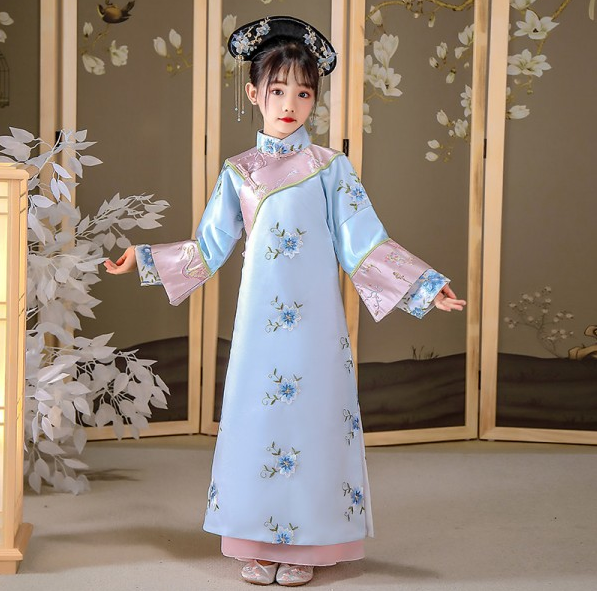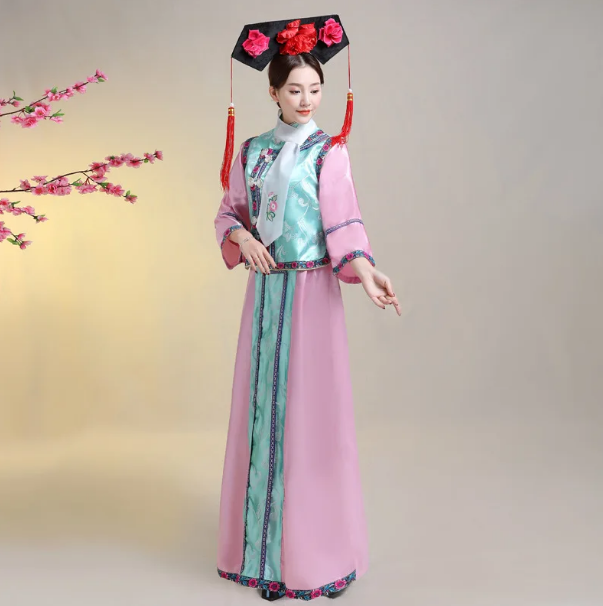Introduction to Qing Dynasty Apparel
The Qing Dynasty, lasting from 1644 to 1912, marked an era of intricate dress codes that reflected one’s status, occupation, and ethnicity within the empire. Court costumes especially symbolized authority and adherence to the societal hierarchy enforced by the ruling Manchus.
The Historical Context of Qing Court Dress
Court costumes from the Qing period tell stories of conquest, cultural assimilation, and governance. The Manchu rulers imposed strict clothing regulations to maintain order and display their power. These regulations underwent adjustments, with earlier periods favoring simpler designs, and later years seeing more ornate elements. Intricate symbols and patterns on these garments conveyed messages about the wearer’s rank and position.

Overview of Qing Dynasty Dress Codes
The dress codes of the Qing Dynasty meticulously categorized garments for various occasions, ranks, and seasons. The royal family, nobles, and officials all had distinctive apparel. For example, the dragon robe Wikipedia, adorned with the imperial dragon, was exclusive to the emperor, symbolizing supreme authority. Each garment’s color, decoration, and material adhered to a set of rules that reflected the meticulous nature of Qing social order.
Imperial Attire of the Qing Dynasty
The Qing Dynasty’s imperial attire stood as a symbol of ultimate authority and divine right. Emperors and empresses wore garments that showcased the pinnacle of craftsmanship and material wealth of the time.
The Emperor’s Ceremonial Garb
The emperor’s ceremonial garb, often called the dragon robe, featured the finest silk and gold thread embroidery. The emperor had numerous robes for different ceremonial occasions, each costing an empire’s fortune. For instance, the cost of a single robe could finance a small army. These robes, often yellow or another auspicious color, displayed dragons with five claws, representing the emperor’s dominance and connection to celestial forces.
Empress and Imperial Consorts’ Regalia
The empress and imperial consorts’ regalia mirrored the emperor’s in luxury and symbolism but included distinctive feminine elements. Their robes often depicted phoenixes, symbolizing high virtue and grace. The materials used in the regalia, primarily silk and pearls, reflected the highest quality available, with a single outfit’s value equaling the income of hundreds of average citizens. The intricate headpieces that accompanied their regalia were equally lavish, studded with precious gems and pearls, showcasing both the imperial family’s wealth and the high-quality craftsmanship of Qing artisans.
Official Garments of the Qing Court
The garments worn by Qing Dynasty officials were not just clothing but a complex language of symbols that communicated the wearer’s rank, position, and function within the government.
Robes for Civil Officials
Civil officials in the Qing court dressed to impress with robes that conveyed their rank through specific, regulated symbols. These officials wore robes with bird insignia, each rank represented by a different bird. The cost of these robes varied greatly depending on rank and material, but even the lowest-ranked official’s attire would equate to the yearly income of an average worker. These garments featured high-quality silks and were often in colors that were rank-specific, with blue and green being common among lower ranks.
Attire for Military Officials
Military officials’ attire featured distinctive round rank badges with fierce animals, reflecting their martial status. For instance, a leopard denoted a third-rank military officer. The durability and quality of these garments were paramount, as they needed to last through rigorous use; thus, the cost of production was significant but seen as a necessary investment. These uniforms not only conveyed the official’s military rank but also their prowess and contributions to the empire’s security. The use of specific symbols and color-coded trims further distinguished the military hierarchy.
Hierarchical Distinctions in Dress
The Qing Dynasty’s dress code was a visual representation of the strict social hierarchy, with every detail from fabric to embroidery denoting the wearer’s position within the court.
Symbolism in Rank Badges and Accessories
Rank badges were pivotal in communicating status among Qing officials. For example, a civil official of the first rank would showcase a crane on his badge, while a fourth-rank officer might display a wild goose. These badges, coupled with accessories like belts and beads, were not just ornamental; they were the wearer’s social identity, encoded in textile form. The cost of these badges and accessories varied, with higher ranks often displaying more elaborate designs and precious materials, representing a substantial financial investment.
Color and Design Variations by Rank
Colors and designs were strictly regulated by rank, providing an immediate visual cue to an individual’s station. Emperors favored bright yellow, the color of the earth’s center and symbolic of his central place in the universe, while princes and other royalty might don robes of blue or red. High-ranking officials had the privilege of wearing robes with dragon motifs, whereas lower ranks were restricted to simpler designs. The fabric’s quality also corresponded to rank, with higher officials donning robes of finer silk, signifying their elevated position and wealth. These differences in color and design served to maintain order and underscore the empire’s rigid structure.
Ritual and Ceremonial Attires
Qing Dynasty’s ritual and ceremonial attires were as much a part of court life as the rituals themselves, each designed to suit the specific occasion’s demands and dignity.
Outfits for Court Ceremonies and Rituals
Court ceremonies required officials and the emperor to dress in attires that reflected their role in the event. The emperor would often wear a robe with dragon motifs and a crown that could be adorned with up to twelve symbolic ornaments. These items were made by the empire’s best craftsmen and could cost as much as a small village’s annual revenue. High-ranking officials also wore specific robes that included embroidered cranes or dragons, depending on their rank, signifying their closeness to imperial power.

Seasonal and Festive Costumes in the Qing Court
Seasonal changes commanded a change in attire to align with the principles of yin and yang and the Five Elements. During the Lunar New Year, bright red garments were common, symbolizing good fortune and joy. The material quality and decoration complexity reflected not only the occasion’s importance but also reinforced social hierarchies. For instance, the emperor’s New Year’s costume might have been embroidered with nine thousand pearls and cost several times the yearly stipend of a mid-rank official. Festivals like the Dragon Boat or the Mid-Autumn festival saw less formal but still elaborate attire, with officials donning garments appropriate to their status and the season’s characteristics.
Evolution and Influence
The Qing Dynasty’s court attire underwent significant transformation over its reign, reflecting political changes and cultural exchanges.
Changes in Qing Court Attire Over Time
Initially, Qing court attire was heavily influenced by Manchu heritage, with garments like the horse-hoof shaped sleeves of the chaopao. Over time, as the dynasty stabilized, Han Chinese elements began to merge. By the late Qing period, Western styles started to make an appearance, especially in accessories and military uniforms. The cost of a complete transition in attire could be immense, reflecting the dynasty’s wealth and openness to incorporating new cultural elements.
The Influence of Qing Court Costumes on Modern Fashion
Qing court costumes have left a lasting impact on modern fashion. Designers often draw inspiration from the rich fabrics and intricate patterns of Qing robes. Traditional elements like mandarin collars, frog buttons, and detailed embroidery have found their way into contemporary designs. The value of such a traditional-inspired modern garment can be high, reflecting both the cost of quality materials and the design’s historical significance. These designs bridge past and present, keeping the Qing Dynasty’s aesthetic alive in the 21st century.







